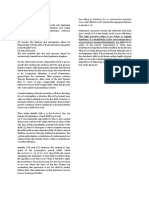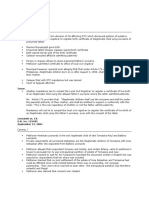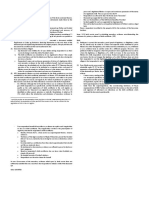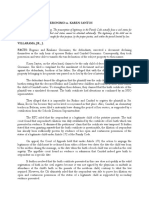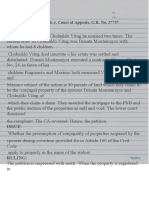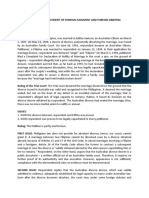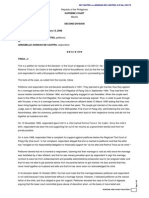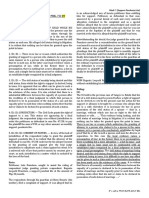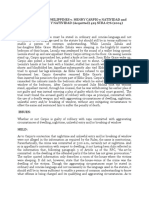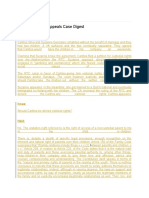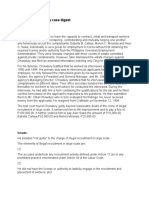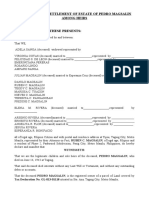Eceta Vs Eceta
Eceta Vs Eceta
Uploaded by
Norman CaronanCopyright:
Available Formats
Eceta Vs Eceta
Eceta Vs Eceta
Uploaded by
Norman CaronanOriginal Title
Copyright
Available Formats
Share this document
Did you find this document useful?
Is this content inappropriate?
Copyright:
Available Formats
Eceta Vs Eceta
Eceta Vs Eceta
Uploaded by
Norman CaronanCopyright:
Available Formats
Eceta v.
Eceta
GR No. 157307, 20 May 2004
FACTS:
Petitioner and her husband acquired several properties, among which is the disputed
property. They begot a son who sired an illegitimate daughter, herein respondent. Upon
his death, petitioner and respondent are his compulsory heirs.
Respondent filed a case before RTC for Partition and Accounting with Damages against
petitioner alleging that by virtue of his father’s death, she became petitioner’s co-heir
and and co-owner of the disputed property. In her answer, Rosalina alleged that the
property is paraphernal in nature and thus belonged to her exclusively.
During the pre-trial conference, the parties entered into a stipulation of facts wherein
they both admitted their relationship to one another, i.e., that petitioner is respondent’s
grandmother.
ISSUE:
Whether the admission made by petitioner that respondent is her granddaughter is
enough to prove respondent’s filiation with the only son of petitioner.
RULING:
No. The filiation of illegitimate children, like legitimate children, is established by (1) the
record of birth appearing in the civil register or a final judgment; or (2) an admission of
legitimate filiation in a public document or a private handwritten instrument and signed
by the parent concerned. In the absence thereof, filiation shall be proved by (1) the
open and continuous possession of the status of a legitimate child; or (2) any other
means allowed by the Rules of Court and special laws. The due recognition of an
illegitimate child in a record of birth, a will, a statement before a court of record, or in
any authentic writing is, in itself, a consummated act of acknowledgement of the child,
and no further court action is required. In fact, any authentic writing is treated not just a
ground for compulsory recognition; it is in itself a voluntary recognition that does not
require a separate action for judicial approval.
Maria Theresa successfully established her filiation with Vicente by presenting a duly
authenticated birth certificate. Vicente himself signed Maria Theresa’s birth certificate
thereby acknowledging that she is his daughter. By this act alone, Vicente is deemed to
have acknowledged his paternity over Maria Theresa.
You might also like
- Motions, Affidavits, Answers, and Commercial Liens - The Book of Effective Sample DocumentsFrom EverandMotions, Affidavits, Answers, and Commercial Liens - The Book of Effective Sample DocumentsRating: 4.5 out of 5 stars4.5/5 (17)
- LAZATIN V CAMPOSDocument2 pagesLAZATIN V CAMPOSChilzia RojasNo ratings yet
- 28.1 Lazatin V Campos DigestDocument3 pages28.1 Lazatin V Campos DigestEstel Tabumfama100% (1)
- Art 152Document9 pagesArt 152Si ZərNo ratings yet
- Case Digest For PersonsDocument4 pagesCase Digest For Personsjohn adamsNo ratings yet
- Eceta Vs EcetaDocument2 pagesEceta Vs EcetaIvan Montealegre ConchasNo ratings yet
- 4th Pers PDFDocument42 pages4th Pers PDFeverydaylaraeNo ratings yet
- Persons 9.3.12Document14 pagesPersons 9.3.12Jil MacasaetNo ratings yet
- Geronimo V SantosDocument2 pagesGeronimo V SantosJanice LivingstoneNo ratings yet
- Geronimo v. SantosDocument3 pagesGeronimo v. SantosDanJalbuna100% (2)
- Geronimo V SantosDocument2 pagesGeronimo V SantosLee SomarNo ratings yet
- Babiera de JesusDocument3 pagesBabiera de JesusBai Johara SinsuatNo ratings yet
- Montefalcon vs. VasquezDocument1 pageMontefalcon vs. VasquezDyane Garcia-AbayaNo ratings yet
- Geronimo V SantosDocument2 pagesGeronimo V SantosLee Somar0% (1)
- Legitimate Children Marissa Benitez-Badua Vs CaDocument13 pagesLegitimate Children Marissa Benitez-Badua Vs CaHEMERHYNI BARAGUIRNo ratings yet
- Herbert Cang Vs CADocument6 pagesHerbert Cang Vs CAGundamBearnardNo ratings yet
- PFR - Case DigestDocument66 pagesPFR - Case DigestJESSIE JAMES YAPAONo ratings yet
- De CastroDocument7 pagesDe CastroFymgem AlbertoNo ratings yet
- Paternity and FiliationDocument45 pagesPaternity and FiliationPhi SalvadorNo ratings yet
- R61 8. Salas vs. MatusalemDocument4 pagesR61 8. Salas vs. MatusalemJessica AbadillaNo ratings yet
- de Castro vs. Assidao de Castro G.R. No. 160172 Feb. 13 2006Document4 pagesde Castro vs. Assidao de Castro G.R. No. 160172 Feb. 13 2006Francise Mae Montilla MordenoNo ratings yet
- G.R. No. 197099 Eugenio San Juan Geronimo, Petitioner, KAREN SANTOS, RespondentDocument5 pagesG.R. No. 197099 Eugenio San Juan Geronimo, Petitioner, KAREN SANTOS, Respondentjim peterick sisonNo ratings yet
- CASE No. 202 Eugenio San Juan Geronimo vs. Karen SantosDocument3 pagesCASE No. 202 Eugenio San Juan Geronimo vs. Karen SantosJonel L. SembranaNo ratings yet
- Paternity and Filiation CasesDocument39 pagesPaternity and Filiation CasesKarla Espinosa100% (1)
- Aguilar Deserve Scant Consideration by This CourtDocument3 pagesAguilar Deserve Scant Consideration by This CourtKORINA NGALOY0% (1)
- De Jesus Vs DizonDocument2 pagesDe Jesus Vs DizonDayday Able100% (4)
- Eceta Vs EcetaDocument5 pagesEceta Vs EcetaHiezll Wynn R. RiveraNo ratings yet
- Montefalcon vs. Vasquez: Case DigestDocument1 pageMontefalcon vs. Vasquez: Case DigestelCrisNo ratings yet
- Paternity and Filiation: Kinds/Status of Children-Legitimate Children, Art. 164 and Art. 54 and 43 (1)Document32 pagesPaternity and Filiation: Kinds/Status of Children-Legitimate Children, Art. 164 and Art. 54 and 43 (1)Sheilah Mae PadallaNo ratings yet
- De-Castro V Assidao-De Castro Gr. No 160172Document5 pagesDe-Castro V Assidao-De Castro Gr. No 160172Ako Si Paula Monghit0% (1)
- Philippine National Bank v. Court of Appeals, G.R. No. 57757 FactsDocument70 pagesPhilippine National Bank v. Court of Appeals, G.R. No. 57757 FactsJessie James YapaoNo ratings yet
- Civ Law Rev - PFR - 090716Document41 pagesCiv Law Rev - PFR - 090716Karla BeeNo ratings yet
- Babiera vs. Catotal, G.R. No. 138493, June 15, 2000 FactsDocument9 pagesBabiera vs. Catotal, G.R. No. 138493, June 15, 2000 FactsMaxencio RiosNo ratings yet
- Petitioner Vs Vs Respondent Estelito P. Mendoza Villaraza & Angcangco Law OfficesDocument12 pagesPetitioner Vs Vs Respondent Estelito P. Mendoza Villaraza & Angcangco Law OfficesEduard RiparipNo ratings yet
- de Castro Vs Assidao - de CastroDocument7 pagesde Castro Vs Assidao - de CastroJane Dela CruzNo ratings yet
- De Castro V de Castro GR 160172 February 13, 2008Document5 pagesDe Castro V de Castro GR 160172 February 13, 2008Iris Jianne MataNo ratings yet
- De Jesus Vs Dizon (PFR Case Digest)Document2 pagesDe Jesus Vs Dizon (PFR Case Digest)Ixhanie Cawal-oNo ratings yet
- Persons and Family Case DigestsDocument11 pagesPersons and Family Case DigestsAra Lim100% (1)
- Angeles V Maglaya (Digest)Document1 pageAngeles V Maglaya (Digest)Liaa Aquino100% (2)
- Benitez-Badua Vs CADocument1 pageBenitez-Badua Vs CAmelbertgutzby vivasNo ratings yet
- Recognition and Enforcement of Foreign Judgment and Foreign Arbitral AwardsDocument11 pagesRecognition and Enforcement of Foreign Judgment and Foreign Arbitral AwardsSachieCasimiroNo ratings yet
- De Castro Vs Assidao-De Castro G.R No 160172Document8 pagesDe Castro Vs Assidao-De Castro G.R No 160172Jonjon BeeNo ratings yet
- De Jesus Vs Estate of Juan DizonDocument9 pagesDe Jesus Vs Estate of Juan DizonMartirez ClarizNo ratings yet
- Rule 130 Sec 39Document17 pagesRule 130 Sec 39Therese JavierNo ratings yet
- De Jesus v. SyquiaDocument2 pagesDe Jesus v. SyquiaMary Louise R. ConcepcionNo ratings yet
- De Jesus vs. Estate of DizonDocument6 pagesDe Jesus vs. Estate of DizonyanaNo ratings yet
- Petitioner vs. vs. Respondents: Second DivisionDocument9 pagesPetitioner vs. vs. Respondents: Second DivisionJian CerreroNo ratings yet
- Francisco V. Zandueta, 61 Phil. 752 DY Syllabus: Week 7 (Support Pendente Lite)Document22 pagesFrancisco V. Zandueta, 61 Phil. 752 DY Syllabus: Week 7 (Support Pendente Lite)Rowela DescallarNo ratings yet
- Adoption Castro vs. Gregorio: HeldDocument14 pagesAdoption Castro vs. Gregorio: HeldIrish AnnNo ratings yet
- Adoption Castro vs. Gregorio: HeldDocument14 pagesAdoption Castro vs. Gregorio: HeldIrish AnnNo ratings yet
- Jison vs. CA, G.R. No. 124853, Feb. 24, 1998Document4 pagesJison vs. CA, G.R. No. 124853, Feb. 24, 1998Mariana Jessa SerranoNo ratings yet
- Liyao vs. Liyao, G.R. No. 138961, March 7, 2002Document3 pagesLiyao vs. Liyao, G.R. No. 138961, March 7, 2002Mariana Jessa SerranoNo ratings yet
- Ako Tonto A.K.A. Ako Gu-An Y Tonto, Represented by His Mother and Guardian, Gina Tonto Y Pinaguan Spec. Pro. No.Document9 pagesAko Tonto A.K.A. Ako Gu-An Y Tonto, Represented by His Mother and Guardian, Gina Tonto Y Pinaguan Spec. Pro. No.Rey Victor GarinNo ratings yet
- de Jesus Vs Estate of DizonDocument3 pagesde Jesus Vs Estate of DizonViner Hernan SantosNo ratings yet
- Persons & Family RelationsDocument30 pagesPersons & Family RelationsMary Grace Dionisio-RodriguezNo ratings yet
- Case Digests and Summary of Doctrines AdoptionDocument11 pagesCase Digests and Summary of Doctrines AdoptionTerence Eyre BelangoyNo ratings yet
- De Jesus V Estate of Dizon - DigestDocument3 pagesDe Jesus V Estate of Dizon - DigestEdwin Villegas de NicolasNo ratings yet
- 1 Castro V GregorioDocument3 pages1 Castro V GregorioRiza L.No ratings yet
- Tayag vs. Tayag-Gallor Case DigestDocument3 pagesTayag vs. Tayag-Gallor Case DigestArmstrong Bosantog100% (2)
- Lim v. Lim, G.R. No. 163209, October 30, 2009Document1 pageLim v. Lim, G.R. No. 163209, October 30, 2009Norman CaronanNo ratings yet
- Mangonan Vs CADocument2 pagesMangonan Vs CANorman CaronanNo ratings yet
- Tayag V Tayag-GallorDocument2 pagesTayag V Tayag-GallorNorman CaronanNo ratings yet
- Memorandum For The PlaintiffDocument5 pagesMemorandum For The PlaintiffNorman CaronanNo ratings yet
- People Vs NatividadDocument2 pagesPeople Vs NatividadNorman CaronanNo ratings yet
- Silva vs. Court of Appeals Case Digest: FactsDocument2 pagesSilva vs. Court of Appeals Case Digest: FactsNorman CaronanNo ratings yet
- Verceles Vs PosadaDocument3 pagesVerceles Vs PosadaNorman CaronanNo ratings yet
- People Vs Chowdury Case Digest: FactsDocument4 pagesPeople Vs Chowdury Case Digest: FactsNorman CaronanNo ratings yet
- Extrajudicial Settlement of Estate of Pedro Magsalin Among HeirsDocument3 pagesExtrajudicial Settlement of Estate of Pedro Magsalin Among HeirsNorman CaronanNo ratings yet
- Romualdez Vs SandiganbayanDocument2 pagesRomualdez Vs SandiganbayanNorman Caronan0% (1)
- Lacson Vs Exec SecDocument3 pagesLacson Vs Exec SecNorman CaronanNo ratings yet
- Zaldivar Vs Gonzales 166 SCRA 316Document1 pageZaldivar Vs Gonzales 166 SCRA 316Norman CaronanNo ratings yet
- Romulo-Vs Yniguez-Case-DigestDocument2 pagesRomulo-Vs Yniguez-Case-DigestNorman CaronanNo ratings yet







